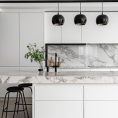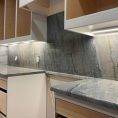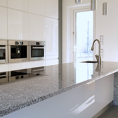Selecting Kitchen Countertops in a Transitional Style
Blending the warmth and charm of a more traditional design with the sleek, functional elements of modern aesthetics, a transitional kitchen offers a little bit of both worlds. Selecting the ideal countertop material is keys to creating a more balanced mix of these two styles. The ideal countertop adds to the kitchen’s beauty while being durable and practical.
Features of a Transitional Kitchen
A transitional kitchen is a mix of both classic and contemporary, which makes them really versatile and timeless. Some key features include:
- A neutral color palette (whites, grays, soft earth tones)
- The project uses a combination of natural and engineered materials
- Simple lines with understated detailing
- between ornate and minimalistic design
Best Countertop Materials for Transitional Kitchens
Governmentagames1: Reflections On A Long Road
Quartz makes for a good transitional kitchen because it is durable, low maintenance, and aesthetic.
- Pros: Non-porous, stain-resistant, comes in a range of colors and patterns that look like natural stone.
- Best Look: Soft white, light gray and marble-look quartz works brilliantly in a transitional design.
Granite: The Timeless Natural Look
Granite is a traditional, yet well-mannered stone that works smart both with facets and even brooding kitchens.
- Advantages: Natural, heat resistant, and comes in a variety of unique patterns.
- Best Look: Variegated quarry stone, neutral-toned with little veining, keeps the design cohesive.
Marble: Elegant and Classic
In any transitional kitchen, a marble countertop instantly lends an elevated touch.
- Pros: Appealing aesthetic, natural veining to give character.
- Cons: Needs to be sealed and maintained regularly.
- Best Look: White or light gray marble, with soft veining, brings out timeless appeal.
Soapstone: A Marvellous Isotal Optimism
Soapstone is a great alternative if you prefer something warmer and organic.
Pros: non-porous, naturally antibacterial, develops a beautiful patina.
Best look: Dark gray or soft black soapstone with subtle veining; looks good with both traditional and modern cabinetry. Butcher block, a rustic yet contemporary option Wood countertops like butcher block add warmth and texture, making them perfect for a transitional kitchen.
Pros: adds warmth; pairs well as an accent on kitchen islands. Cons: requires maintenance and sealing. Best look: Light oak or walnut butcher block, works well with white or gray cabinetry. 3. Choosing the right color and finish Choose neutral shades such as white, beige, gray, or soft browns to maintain the desired transitional style. Avoid highly polished finishes and overly bold colors, as subtle matte or honed finishes work better overall to keep the balance. 4. Blending countertops with other elements A well-designed transitional kitchen effortlessly combines countertops, backsplash, cabinetry, and hardware. Choose marble or quartz countertops with shaker-style cabinetry for a classic yet modern look. Opt for a subway tile or herringbone backsplash – timeless classics. Add mixed metal hardware, such as brass, black, or nickel, to create depth and visual interest. Conclusion Selecting a countertop for a transitional kitchen involves striking a balance between traditional charm and modern convenience. Mayo Clinic Proceedings Looking for practicality, elegance, or warmth in quartz, marble, or butcher block, respectively, the goal is to keep your materials, colors, and finishes in harmony. A well-made and timely decision will reward you with a transitional kitchen that emerges timeless and inviting.






